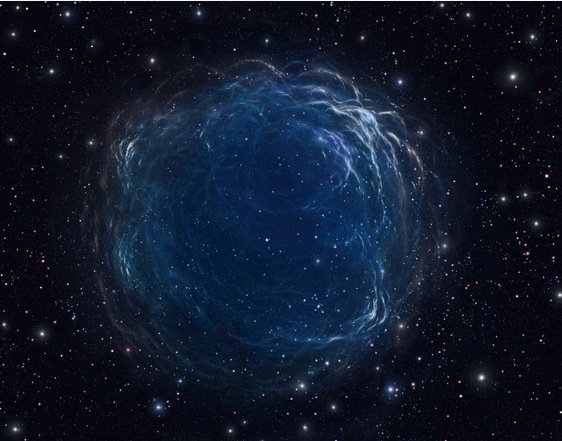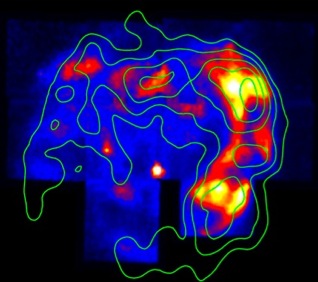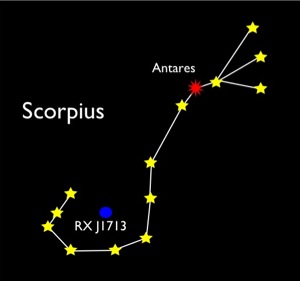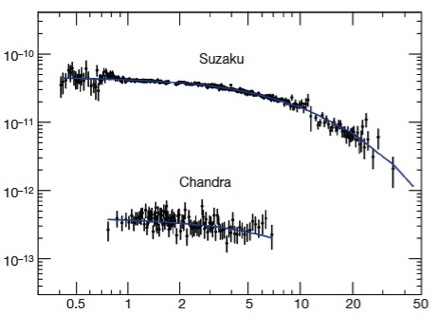


Press Release
Extremely Fast Acceleration of
Cosmic Rays in a Supernova Remnant









RX J1713.7-3946









Fig. 1 (Left) SNR RX J1713.7-3946 in the constellation Scorpius. (Right) X-ray image of RX J1713.7-3946 taken by the Suzaku satellite (color) is overlaid with the morphology in VHE gamma-rays (contours). The western shell (to the right in the figure) is bright in both x-ray and gamma-rays.
What We Found:
Using NASA's Chandra X-ray Observatory, the team obtained multi-epoch x-ray images with high spatial resolution (1 arcsec) aiming at measuring the proper motion of the SNR shell. Chandra images taken in 2000, 2005, and 2006 were compared to derive the proper motion (and therefore the speed of the shock), which in turn gives us an age estimate for this remarkable supernova remnant. Surprisingly, the team found temporal variability in the x-ray strength of compact features from 2000 to 2005, and also from 2005 to 2006 (Fig. 2). The year-scale variability indicates that we have witnessed, for the first time, the "real time" production of cosmic rays in the supernova shell. Moreover, the variability is observational evidence in support of the substantial amplification of the magnetic field in the shock of the supernova remnant. In fact, the amplification of the magnetic field is a key ingredient of the theory
of cosmic-ray acceleration, and has recently been predicted theoretically (though the microscopic physical processes have yet to be explored). Independently, the team used a new hard x-ray detector on the Japanese Suzaku satellite in order to measure the wide-band x-ray spectrum up to 40 keV (Fig. 3). The spectroscopic measurements revealed that the x-ray intensity falls rapidly above 5 keV--a
spectral cutoff. Modeling the position of the cutoff by the acceleration theory indicates that the acceleration takes place in extremely tangled magnetic fields that allow particles to be scattered and accelerated in the most effective way. The new findings provided by the Chandra and Suzaku data led the team to conclude that protons can be accelerated in the SNR shock front to energies at least of the order of 1 PeV, thus capable of accounting for the cosmic rays arriving at Earth.




Fig. 2 Taken from Uchiyama et al. 2007. (a) the western shell of SNR RX J1713.7-3946 in x-rays (color) and VHE gamma-ray (contours). (b) zooming up box b in the left panel. An x-ray feature in 2000 disappeared before 2005. (c) zooming up box c. A new x-ray feature appeared between 2000 and 2005, and then disappeared between 2005 and 2006.




RX J1713.7-3946 drawn by an artist.
Team Members:
Dr. Yasunobu Uchiyama, Prof. Tadayuki Takahashi, Dr. Yoshitomo Maeda
Institute of Space and Astronautical Science, Japan Aerospace Exploration Agency (ISAS/JAXA), Japan
Prof. Felix Aharonian
Dublin Institute for Advanced Studies, Ireland, and
Max-Planck-Institut fur Kernphysik, Germany.
Dr. Takaaki Tanaka
KIPAC, Stanford Linear Accelerator Center, USA.
Using NASA's Chandra X-ray Observatory, a team of Japanese astrophysicists led by Yasunobu Uchiyama at ISAS/JAXA has reported the detection of extremely fast, year-scale variability in the X-ray flux from the supernova remnant RX J1713.7-3946. The remarkable variability, in the form of brightening and decaying, means that we have witnessed the acceleration of cosmic rays in a "real time" manner, providing new evidence to support the long- standing conjecture that the shock front of a supernova remnant (SNR) accelerates the galactic cosmic rays arriving at Earth. Moreover, the variable X-ray emission implies the substantial amplification of magnetic fields at supernova shocks. Combining the spectroscopic results obtained with the Japanese Suzaku X-ray satellite, we conclude that the supernova remnant is capable of accelerating cosmic-ray particles to energies of the order of 1 PeV (1E15 eV).
Uchiyama et al. Nature, October 4, 2007
Supernova Remnant (SNR) RX J1713.7-3946:
SNR RX J1713.7-3946 (Fig. 1) is located in the Milky Way inside the tail of the constellation Scorpius. It is the remnant of a supernova that most likely exploded in A.D. 393 as indicated by Chinese historical records, and is quite unique in the sense that the radiation from this SNR is dominated by a "non-thermal" X-ray component. Remarkably, its glow has been detected also in very-high-energy (VHE) gamma-rays. This SNR was the first celestial object for which the morphology in VHE gamma-rays was revealed by the HESS experiment using ground-based Cherenkov telescopes. Given the properties in x-rays and VHE gamma-rays, this SNR is most suited for the study of cosmic-ray acceleration in our galaxy.



X-ray Energy (keV)
Flux (cgs)




Fig. 3 Taken from Uchiyama et al. 2007. The X-ray spectra of SNR RX J1713.7-3946. The Suzaku spectrum is extracted from the southwest shell, while the Chandra spectrum is from box b in Fig. 2.
Contact:
Dr. Yasunobu Uchiyama
uchiyama "followed by" @astro.isas.jaxa.jp